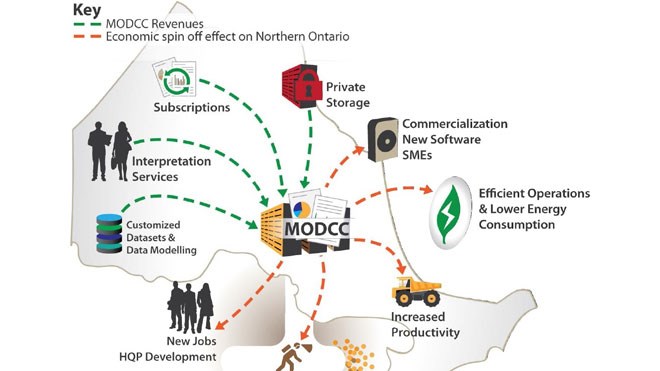Two heads are better than one.
The Centre for Excellence in Mining Innovation (CEMI) has taken that old saying to heart with its plans to collaborate with Sudbury's SNOLAB to create a mining observatory data control centre.
“It's an opportunity for us to collect, share and redistribute mining-related research and development data unlike how we've ever been able to do it before,” said Damien Duff, CEMI's vice-president of geoscience and geotechnical research and development.
The new data centre will build on existing telecommunications infrastructure at SNOLAB, an underground laboratory that focuses on advanced physics, to allow mining companies to share their data with each other and with researchers.
Duff said university researchers and corporations can make advancements much faster when they know what others are working on in their field and build on that knowledge.
The mining industry already collects large amounts of data through underground sensors and measurement devices attached to just about every piece of mining equipment.
An underground scoop tram, for example, may collect data on its own performance. If researchers have access to that data they can figure out ways to optimize that performance and create new efficiencies.
But the potential for improved data collection, and the sharing of that data, goes further.
“If you have the same kind of data from multiple equipment types operating throughout a mine, analyzing may lead you to optimize not only the performance of each machine, but of all the machines as a collection of units,” Duff said.
Duff said mining companies often hire consultants to solve specific and technical problems. A problem that should take three months to solve, he said, can take up to nine months or a year because so much time is spent collecting the necessary data.
“It's all over Hell's half acre,” Duff said.
To help CEMI and SNOLAB start the project, the province's Northern Ontario Heritage Fund Corporation is contributing $750,000 to help build the mining observatory data control centre.
“Our investment in this project is providing an opportunity for academia and industry to work together to establish a much-needed mining information data processing centre that will be very helpful in planning new mining projects such as developing the next generation of tools and protocols for mining at deeper levels,” said Micheal Gravelle, Ontario's Minister of Northern Development and Mines, when the funding was announced in October.
The Canadian Mining Innovation Council (CMIC) and two smaller companies – Montreal-based Mira Geoscience and Sudbury's Objectivity – have also come on board the project.
CMIC, based in Ottawa, has experience with mining-related data-sharing through its Footprints project, which aims to identify the the makeup for ore bodies.
Mira Geoscience and Objectivity, which both have experience building data management and analysis tools, will work to commercialize the data centre once it has been built.
Duff said some mining companies may hesitate to share their data with just anyone. Mira Geoscience and Objectivity could develop security measures to ensure data is only shared with approved partners.
Once the project is commercialized, companies might need to pay to access certain types of data.
Join Sudbury.com+
- Messages
- Post a Listing
- Your Listings
- Your Profile
- Your Subscriptions
- Your Likes
- Your Business
- Support Local News
- Payment History
Sudbury.com+ members
Already a +member?
Not a +member?
Sign up for a Sudbury.com+ account for instant access to upcoming contests, local offers, auctions and so much more.
